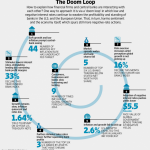
This Is The NIRP “Doom Loop” That Threatens To Wipe-out Banks And The Global Economy
By Tyler Durden Zero Hedge, on 02/12/2016
Remember the vicious cycle that threatened the entire European banking sector in 2012?
It went something like this: over indebted sovereigns depended on domestic banks to buy their debt, but when yields on that debt spiked, the banks took a hit, inhibiting their ability to fund the sovereign, whose yields would then rise some more, further curtailing banks’ ability to help out, and so on and so forth.
Well don’t look now, but central bankers’ headlong plunge into NIRP-dom has created another “doom loop” whereby negative rates weaken banks whose profits are already crimped by the new regulatory regime, sharply lower revenue from trading, and billions in fines. Weak banks then pull back on lending, thus weakening the economy further and compelling policy makers to take rates even lower in a self-perpetuating death spiral. Meanwhile, bank stocks plunge raising questions about the entire sector’s viability and that, in turn, raises the specter of yet another financial market meltdown.
Below, find the diagram that illustrates this dynamic followed by a bit of color from WSJ:
In a way, the move below zero was a gamble. The theory went like this: Banks would take a hit, but negative rates would get the economy moving. A stronger economy would, in turn, help the banks recover.
It appears that wager isn’t working.
The consequences are deeply worrying. Weak banks may now drag the economy down further. And with the economy weak and deflation—a damaging spiral of falling wages and prices—looming, central banks that have gone negative will be loath to turn around and raise rates.
Moreover, central banks have few other levers to escape that doom loop. The ECB has instituted a bond-buying program, but President Mario Draghi last month indicated he was ready to launch additional monetary stimulus in March. Japan’s decision to implement negative rates follows three years of aggressive monetary easing, aimed at ending two decades of low inflation and stagnant growth.
The pushes into negative territory also amount to a sort of competitive currency war that no one seems willing to call off.
Major economies around the world are desperate to spur inflation; one way to do that is to cut interest rates, which typically would make their currencies less attractive. Lower currencies raise the prices of imported goods and boost the fortunes of exporters.
Switzerland, Sweden and Denmark have all used negative rates to help ward off inflows of foreign funds that push up their currencies. Economists said an aim of the Bank of Japan’s move to negative rates last month was to weaken the yen. It hasn’t worked: The yen shot up Thursday and is stronger than it was before the rate cut.
The move below zero compounds the miseries for lenders in those countries. Banks traditionally make a profit by lending at higher interest rates than the rates they pay on deposits, a difference called the net interest margin. Low rates have already squeezed that margin, and banks’ funding costs from other sources, such as bond markets, have surged this year.
German banks earn roughly 75% of their income from the margin between rates on savings accounts and the loans they make, according to statistics from the
Bundesbank, the country’s central bank. Plunging rates dragged German banks’ interest revenue down to €204 billion ($230 billion) in 2014 from €419 billion in 2007, according to the Bundesbank.
Negative rates cost Danish banks more than 1 billion kroner ($151 million) last year, according to a lobbying group for Denmark’s banking sector.
Consider that and then have a look at the following chart, which certainly seems to indicate that we are on step 8 in WSJ’s doom loop…

Step 9 is when things really start to go south for the real economy. So buckle up.




 02/15/2016 - The NIRP “Doom Loop” That Threatens To Wipe-out Banks And The Global Economy
02/15/2016 - The NIRP “Doom Loop” That Threatens To Wipe-out Banks And The Global Economy


